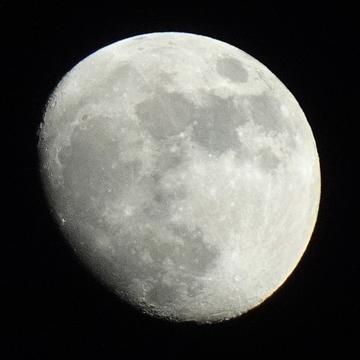Young magmas on the Moon came from much shallower depths than previously thought

Image Credit: Waxing Gibbous Moon, ThePhilosopherAccount (Wikimedia Commons, CC BY 4.0)
New research on the rocks collected by China's Chang'e 5 mission is rewriting our understanding of the geological history of the Moon. An international research team, including Oxford Earth Sciences’ Associate Professor Richard Palin, has shown that lava on the near side of the Moon originated from a much shallower depth than previously thought, contradicting previous theories about the generation of magma in the lunar mantle.
These samples of basalt, an igneous rock made up of rapidly cooled lava, were collected from the near side of the Moon by the Chang’e 5 mission. They are the youngest samples collected on any lunar mission, making them an invaluable resource for those studying the geological evolution of the Moon.
In order to estimate how deep within the Moon the Chang’e 5 lavas originated, the team conducted high-pressure and high-temperature experiments on synthetic powders with an identical composition to the returned samples. These experiments were supplemented by petrological models that indicate magma generation at depths as shallow as ~75 km, much closer to the surface than previously assumed.
Previous work from Chinese scientists has determined that the lavas erupted about 2 billion years ago, and remote sensing indicates that they erupted in an area of the Moon with very high abundances of potassium, thorium and uranium, all of which are radioactive and produce heat. In sufficient concentrations, these elements can generate enough heat to keep the Moon hot near the surface, slowing its rate of cooling over time.
“Using our experimental results and thermal evolution calculations, we put together a simple model showing that an enrichment in radioactive elements would have kept the Moon's upper mantle hundreds of degrees hotter than it would have been otherwise, even at 2 billion years ago” explained Stephen Elardo (University of Florida), who led the study.
These findings contradict the previous theory that the temperature of the Moon’s outer portions was too low to support melting of the shallow interior by that time and so challenges existing models for how the Moon cooled. Prior to this study, the generally accepted theory was that the Moon cooled from the top down. It was presumed that the mantle closer to the surface cooled first as the surface of the Moon gradually lost heat to space, and that younger lavas like the one collected by Chang’e 5 must have come from the deep mantle where the Moon would still be hot. This theory was backed by data from seismometers placed during the Apollo moon landings, but these findings suggest that there were still pockets of shallow mantle hot enough to partially melt even late into the Moon’s cooling process.
“Lunar magmatism, which is the record of volcanic activity on the Moon, gives us a direct window into the composition of the Moon's mantle, which is where magmas ultimately come from. We don't have any direct samples of the Moon's mantle like we do for Earth, so our window into the composition of the mantle comes indirectly from its lavas.”
- Stephen Elardo (University of Florida), lead author of the study
Establishing a detailed timeline of the Moon’s evolution represents a critical step towards understanding how other celestial bodies form and grow. Cooling and differentiation into crusts, mantles, and cores are key geological steps in the “life cycles” of other rocky bodies in our solar system, and beyond. As our closest neighbour in the solar system, the Moon offers us our best chance of learning about these processes.
“I was very excited to be a part of this study” explained Richard Palin (Oxford Earth Sciences). “I have had a long-standing research interest in the geological evolution of the Moon, and our results fundamentally recalibrate our understanding of how and why it remained volcanically active for so long after crystallization of its magma ocean. By identifying that shallow-mantle magma sources can be sustained for hundreds of millions of years by localized radioactive heating, our work also indicates that we may need to re-examine models of crust–mantle evolution in other small rocky bodies in our solar system”.
The study ‘A shallow mantle source for the Chang’e 5 lavas reveals how top-down heating prolonged lunar magmatism’ is available to read in the journal Science Advances at https://doi.org/10.1126/sciadv.adr1486.
This article was adapted from an original news story authored by Brian Smith, which was published on the University of Florida website.
Header image: Portion of the Moon, Archives New Zealand (Flickr, CC BY 2.0)




